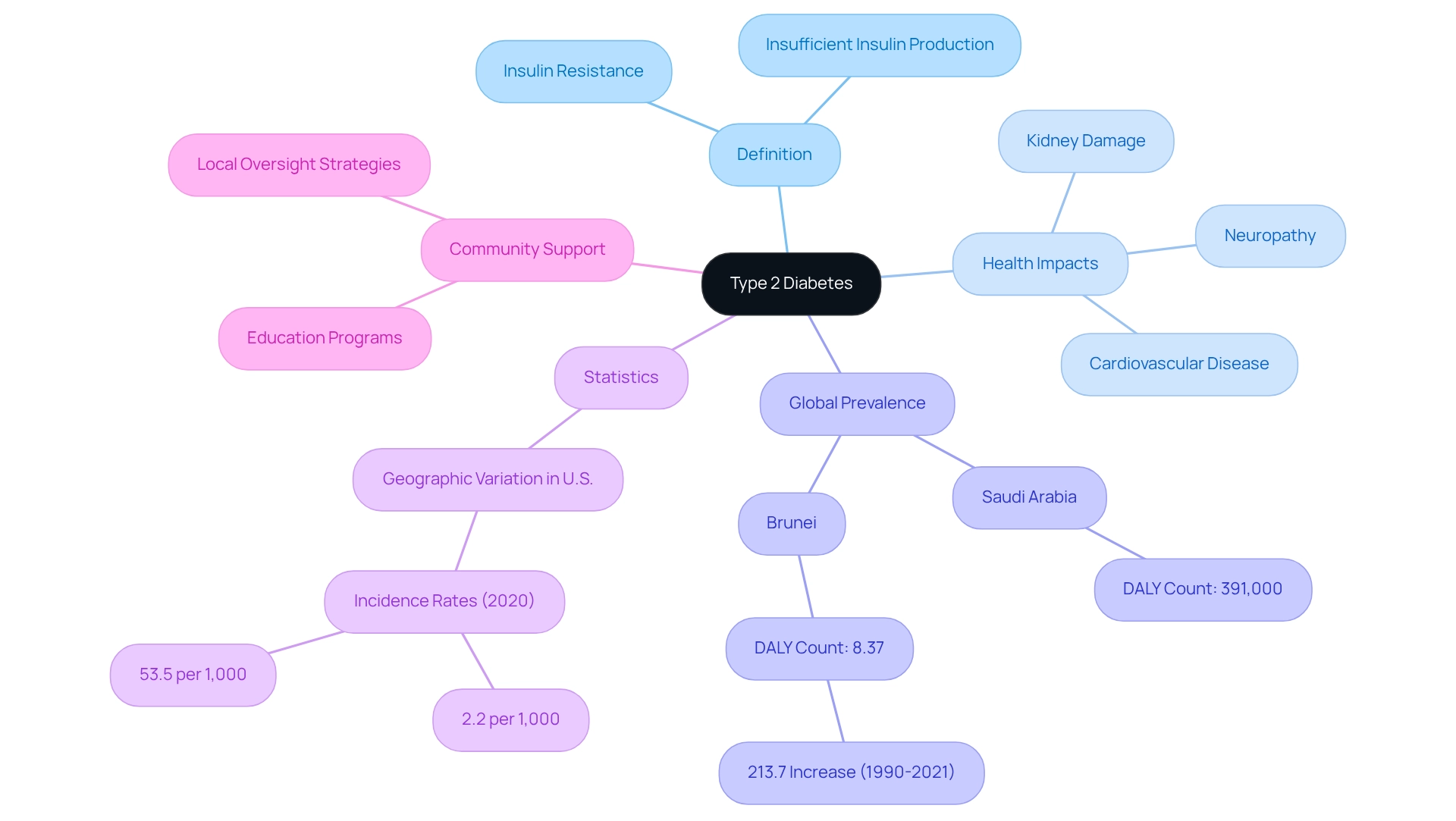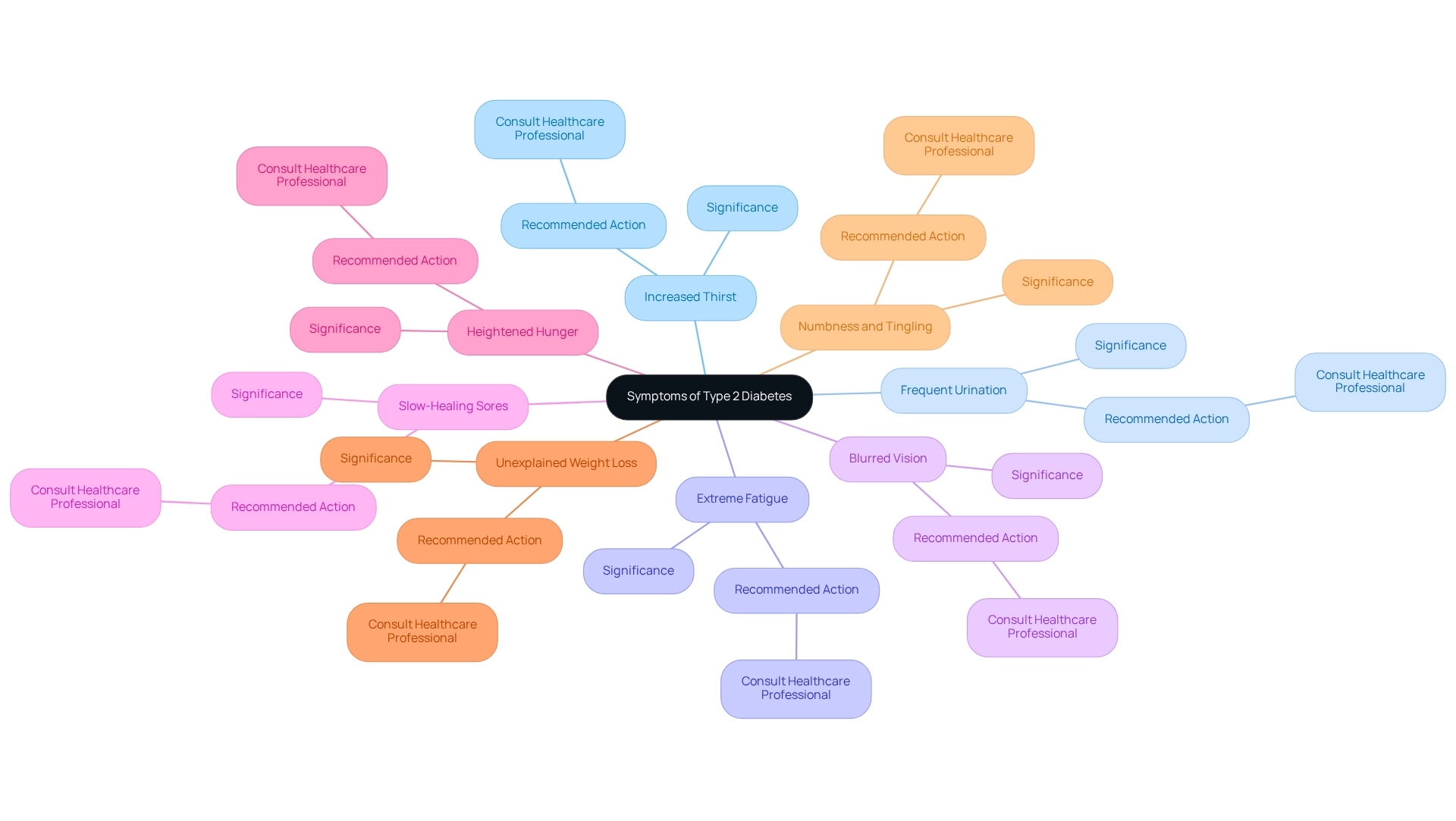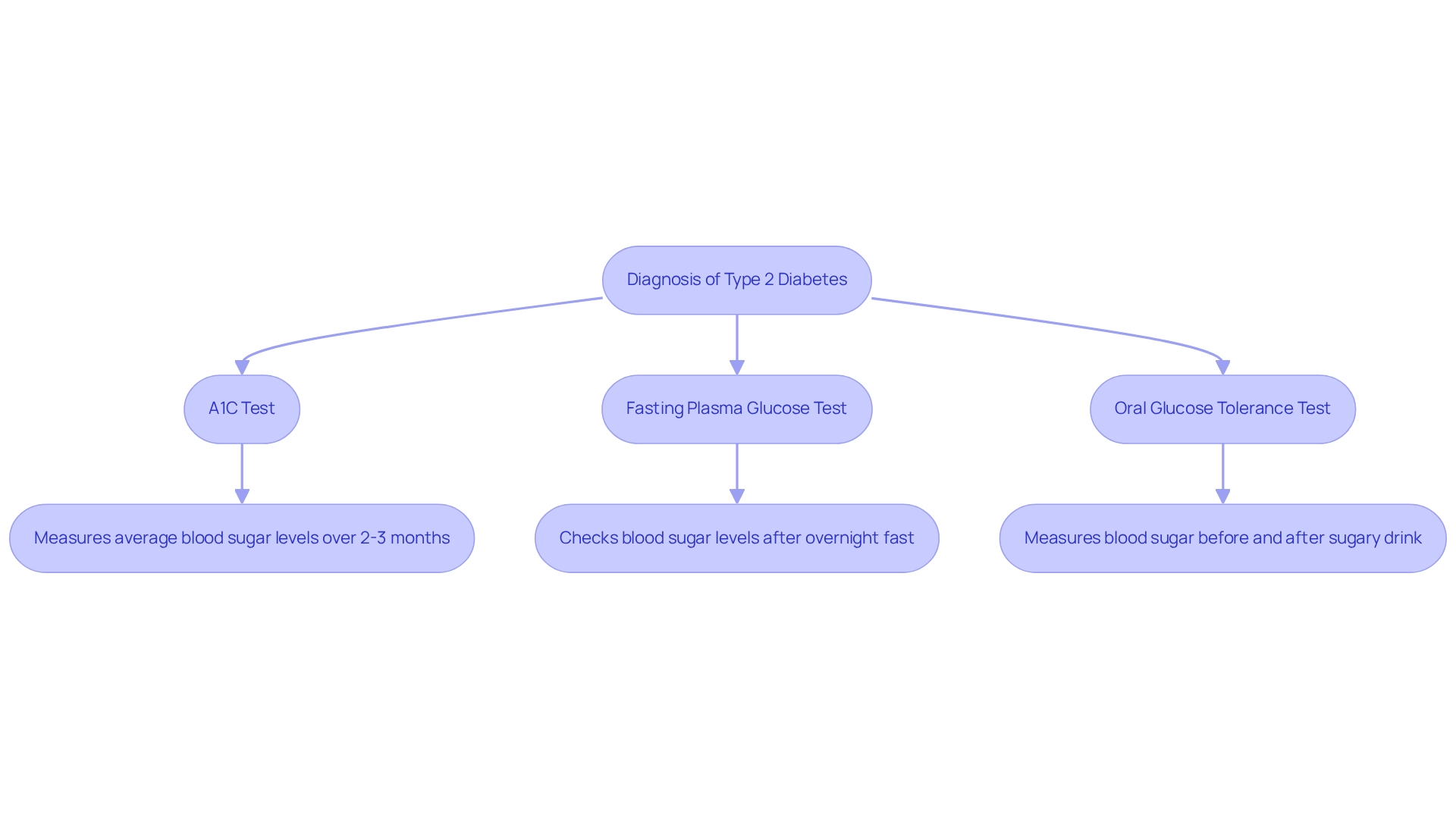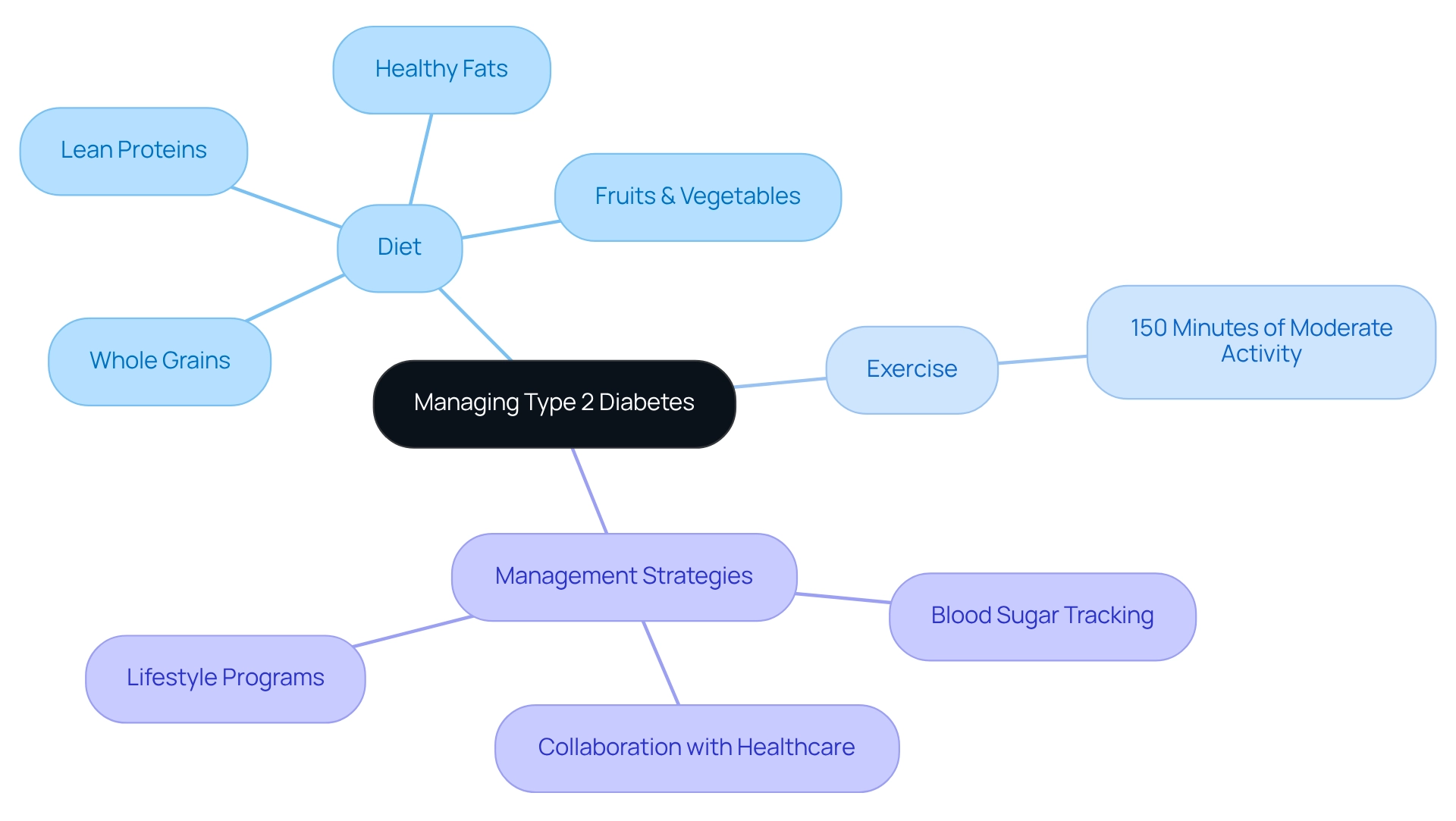Overview
Type 2 diabetes is a serious condition that can feel overwhelming. It is characterized by the body's inability to effectively use insulin, leading to elevated blood sugar levels. This can result in long-term complications, such as cardiovascular disease and kidney damage.
It's understandable to feel concerned when faced with alarming statistics about its prevalence and the severe health impacts it can have. Recognizing early symptoms and taking proactive management steps is crucial. By doing so, you can improve your health outcomes and take control of your journey.
Remember, you're not alone in this journey. There are resources and support available to help you navigate this condition. We are here to support you every step of the way.
Introduction
In a world grappling with rising health challenges, Type 2 Diabetes emerges as a pressing concern that affects millions globally. This chronic condition, characterized by the body’s ineffective use of insulin, poses serious risks, including cardiovascular complications and kidney damage. With alarming statistics indicating a surge in diabetes cases, it’s understandable to feel overwhelmed. Recognizing the importance of understanding its symptoms, diagnosis, and management strategies becomes crucial for individuals and communities alike.
By delving into the intricacies of Type 2 Diabetes, we aim to equip you with the knowledge necessary to navigate this complex health issue. From recognizing early signs to implementing lifestyle changes, our goal is to enhance your quality of life. Remember, you're not alone in this journey; we are here to support you every step of the way.
Understand Type 2 Diabetes: Definition and Overview
Diabetes mellitus type 2 is a persistent condition that can feel overwhelming, and it is important to understand how serious is diabetes type 2, as it is marked by the body's struggle to effectively utilize insulin, a hormone vital for controlling blood sugar levels. This resistance to insulin or insufficient insulin production can lead to increased glucose levels, prompting questions about how serious is diabetes type 2, which may result in serious medical complications over time, such as cardiovascular disease, kidney damage, and neuropathy. It's concerning to note how serious is diabetes type 2, given the alarming prevalence and significant variations observed globally. For instance, in 2025, the occurrence of diagnosed blood sugar conditions in certain regions has shown stark differences, highlighting the need for tailored public health strategies to address local needs.
Recent statistics emphasize the urgency of this issue:
- In Saudi Arabia, the disability-adjusted life years (DALY) due to the condition reached 391,000.
- Brunei experienced a staggering 213.7% increase in DALY from 1990 to 2021, totaling 8.37.
Furthermore, the International Diabetes Federation stresses the critical need for precise data to inform effective initiatives aimed at combating this growing epidemic. It’s understandable to feel concerned about these numbers, but remember, you’re not alone in this journey.
Understanding how serious is diabetes type 2 is crucial for effective control. Successful programs have shown that education and community support can significantly improve patient outcomes. For example, case studies reveal that localized oversight strategies can lead to better wellness outcomes, as evidenced by the geographic variation in diabetes incidence across U.S. counties, where rates ranged from 2.2 to 53.5 per 1,000 individuals in 2020. Together, we can navigate these challenges and find effective ways to manage this condition.
The impact of diabetes extends beyond personal well-being, influencing families and communities. By recognizing the symptoms and understanding the condition, individuals can make informed choices regarding their health, paving the way for effective oversight and enhanced quality of life. Remember, we are here to support you every step of the way. Sharing your experiences with others can foster connection and create a supportive community that uplifts everyone.

Identify Symptoms: Recognizing the Signs of Type 2 Diabetes
Common symptoms of Type 2 Diabetes include increased thirst, frequent urination, extreme fatigue, blurred vision, and slow-healing sores. You might also notice heightened hunger, unexplained weight loss, or numbness and tingling in your hands or feet. These symptoms can develop gradually, making them easy to overlook. It's understandable that many individuals may not recognize how serious diabetes type 2 is until complications arise. For instance, around 73,000 lower-limb amputations were conducted in diabetics aged 20 and above, which illustrates how serious diabetes type 2 is when identification and treatment are delayed.
If you notice any of these symptoms, it's crucial to consult a healthcare professional for further evaluation and potential testing. Swiftly responding to these indicators can lead to more effective management of the condition and help avoid complications, highlighting how serious diabetes type 2 is. Real-life experiences from patients highlight how serious diabetes type 2 is, emphasizing the importance of closely monitoring symptoms; early intervention can significantly enhance outcomes. Regular blood sugar monitoring, whether through glucose meters or continuous glucose monitors, provides critical information that aids in making informed decisions about diet, activity, and medication. Recognizing the gradual emergence of symptoms is vital for prompt action and effective management of your health.
At T2DSolutions, we are dedicated to offering resources and assistance for individuals managing Type 2 Diabetes. You're not alone in this journey; we are here to support you every step of the way as you navigate your health with confidence.

Evaluate Diagnosis: Understanding Tests and Assessments
Diagnosing Type 2 Diabetes can feel overwhelming, but understanding the process is essential. Healthcare providers typically use several tests to help determine your condition, including:
- A1C test
- Fasting plasma glucose test
- Oral glucose tolerance test
The A1C test measures your average blood sugar levels over the past two to three months. If your A1C level is 6.5% or higher, it indicates diabetes. This information is crucial as it helps your healthcare provider understand your situation better.
The fasting plasma glucose test checks your blood sugar levels after an overnight fast, while the oral glucose tolerance test measures your blood sugar levels before and after consuming a sugary drink. It's understandable to feel a mix of emotions as you navigate these tests.
By understanding these tests, you can engage more effectively with your healthcare provider and take an active role in your diagnosis and management. Remember, you're not alone in this journey. We are here to support you every step of the way.

Implement Lifestyle Changes: Diet, Exercise, and Management Strategies
Managing Type 2 Diabetes can feel overwhelming, especially when considering how serious is diabetes type 2, but you are not alone in this journey. Significant lifestyle changes, especially in diet and exercise, are essential. A balanced diet should focus on:
- Whole grains
- Lean proteins
- Healthy fats
- Plenty of fruits and vegetables
It's important to minimize processed foods, added sugars, and saturated fats to support your health. Did you know that 8.0% of U.S. adults diagnosed with Type 2 Diabetes have non-HDL cholesterol levels of 190 mg/dL or above? This emphasizes how serious is diabetes type 2, making effective dietary control crucial.
Regular physical activity is equally vital. Aim for at least 150 minutes of moderate aerobic exercise each week, such as brisk walking or swimming. This aligns with the Community Preventive Services Task Force's recommendations for combining dietary and exercise guidance to improve blood sugar control. Additionally, tracking your blood sugar levels regularly and collaborating with healthcare professionals to tailor your care plan can significantly enhance your management, especially when considering how serious is diabetes type 2.
Recent case studies show the positive impact of lifestyle changes on blood sugar control. For example, increasing public awareness about the differences between Type 1 and Type 2 diabetes can lead to better understanding and personalized management strategies. Professional insights emphasize that effective diet and exercise approaches can lead to notable improvements in overall wellness. As Mary Beth Weber, PhD, MPH, wisely states, "Collaborating with community-based lifestyle programs, establishing patient referrals to such programs, creating multidisciplinary teams to provide patient education and follow-up, training physicians on effective brief counseling, and using health information technologies to promote behavior change represent the most promising strategies." Remember, small, consistent changes can lead to significant enhancements in your overall well-being. We are here to support you every step of the way.

Conclusion
Type 2 Diabetes is a significant health challenge that requires urgent attention and proactive management. Understanding this chronic condition is essential, as it can lead to serious complications such as cardiovascular disease and kidney damage. The rising incidence of diabetes worldwide underscores the need for effective public health strategies and community support.
Recognizing symptoms like increased thirst, frequent urination, and extreme fatigue is crucial for early intervention. It's understandable to feel overwhelmed by these signs, but many individuals may overlook them until complications develop. Timely consultation with healthcare professionals is vital for better outcomes. Regular monitoring of symptoms and blood sugar levels empowers individuals to take charge of their health.
Diagnosis through tests such as the A1C test and fasting plasma glucose test facilitates active engagement with healthcare providers. Understanding these diagnostic tools promotes collaboration in managing diabetes. Furthermore, adopting lifestyle changes—particularly in diet and exercise—plays a critical role in effective management. A balanced diet and regular physical activity can lead to significant improvements in overall health and diabetes control.
In summary, managing Type 2 Diabetes requires awareness, early recognition of symptoms, proper diagnosis, and commitment to lifestyle changes. You're not alone in this journey; prioritizing education and community support enables individuals to enhance their quality of life and reduce health risks. With appropriate resources and strategies, effective management of Type 2 Diabetes is attainable, paving the way for a healthier future. We are here to support you every step of the way.
Frequently Asked Questions
What is type 2 diabetes?
Type 2 diabetes mellitus is a chronic condition where the body struggles to effectively use insulin, leading to increased glucose levels in the blood.
What are the serious complications associated with type 2 diabetes?
Serious complications can include cardiovascular disease, kidney damage, and neuropathy, which can arise from prolonged high glucose levels.
How prevalent is type 2 diabetes globally?
The prevalence of diagnosed blood sugar conditions varies significantly across regions, with alarming statistics highlighting the need for tailored public health strategies.
What are some statistics related to type 2 diabetes?
In Saudi Arabia, the disability-adjusted life years (DALY) due to type 2 diabetes reached 391,000. In Brunei, there was a 213.7% increase in DALY from 1990 to 2021.
Why is accurate data important in addressing type 2 diabetes?
Precise data is essential for informing effective initiatives aimed at combating the growing epidemic of type 2 diabetes.
How can education and community support impact type 2 diabetes management?
Successful programs that focus on education and community support have shown to significantly improve patient outcomes and wellness.
What variations exist in diabetes incidence in the U.S.?
In 2020, diabetes incidence rates across U.S. counties ranged from 2.2 to 53.5 per 1,000 individuals, showcasing geographic differences in the condition's prevalence.
How does diabetes affect families and communities?
The impact of diabetes extends beyond individual health, influencing families and communities, and emphasizing the importance of recognizing symptoms and understanding the condition for informed health choices.



